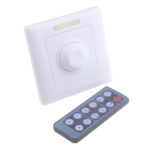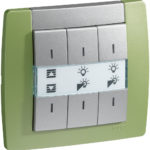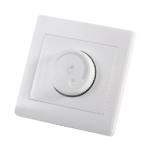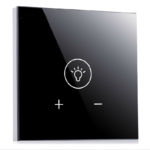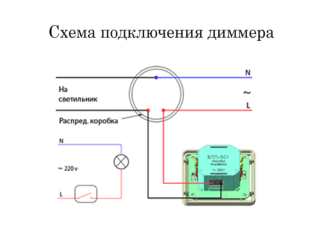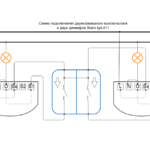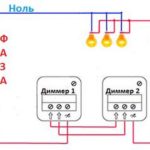The brightness of home lighting can be excessive or insufficient - it all depends on the mood, setting and purpose of the room. This parameter can be easily adjusted with a slight movement of the hand using the dimmer. The dimmer allows you to reduce or increase the brightness of artificial light in different rooms of the house or in its individual parts.
The advantages of using dimmers and how it works
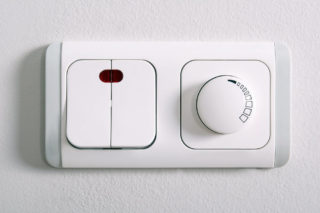
A dimmable switch allows you to:
- reduce the amount of electricity consumed;
- it is interesting to zone the space of the apartment using different intensity of light fluxes;
- rationally use the lighting devices available in the house;
- it is easy to create an environment that matches your wishes and mood;
- to exclude the impact on lighting devices of sudden voltage drops.
The use of dimmers allows you to solve a number of aesthetic and practical problems. This largely determined the popularity of the devices and their widespread use in the arrangement of residential and commercial premises.
The operation of the device is based on the principle of linear dependence of the brightness of light on voltage. You can reduce the power of the luminous flux by lowering the voltage level in the network. This task is assigned to the dimmer - dimmer. Its design allows only part of the pulsed wave or the entire wave to pass to the lamp, thereby reducing or increasing illumination.
Classification and characteristics
Dimmable switches can be divided into the following groups:
- Modular models - designed for installation in distribution boards to which light sources are connected in corridors and staircases of multi-storey buildings. The device is connected to work with a button or a rocker switch. Pressing and holding it for a few seconds gives access to the dimming option.
- Dimmers for back boxes - used in conjunction with incandescent and halogen lamps. You can control the device through a special remote button.
- Monoblock models - used as ordinary household switches.
The latest product designs that have become widespread can be managed in the following ways:
- Rotary dimmers - the brightness of the luminous flux is controlled by turning the knob of the device.
- Push and turn models - pushing and turning the knob allows you to turn on the lamp and at the same time change its power to the required level.
- Key dimmers - one of the keys turns on the lamp, the other allows you to change its brightness.
- Sensory - the latest generation models. Several built-in touch sensors allow you to turn on the lamp and change the brightness of the light. The smoothness of the switching is somewhat deceiving - the change in the luminous flux power occurs in steps, without intermediate values, but with a small gap in brightness level. The absence of moving parts has led to the high reliability of devices of this type and their long-term trouble-free operation.
- Dimmers with a remote control - allow you to change the brightness of the lighting in a remote mode, while manually adjusting its power.
Most manufacturers are ready to offer the buyer additional useful functions: the ability to program the automatic shutdown time and voice control. The effect of presence at the time of departure of the owner is also useful: the light is randomly turned on and off, its brightness changes during the day.
Compatibility of dimmers and lamps of various modifications
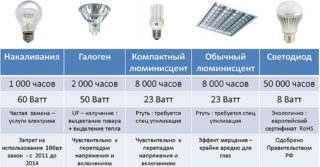
Dimmers are designed to work with a specific type of lamp - from standard incandescent bulbs to popular LEDs. Therefore, dimmable switches have their own characteristics.
Almost all dimmer models can be used for joint use with halogen lamps and incandescent bulbs, if they are designed to operate on a 220V network. It should be noted that when the voltage applied to the lamp decreases, the artificial light acquires an unpleasant red tint, which is especially noticeable when the minimum current is applied. Such light irritates the organs of vision, leading to their rapid fatigue.
An important requirement is imposed on dimmers for low-voltage halogen lamps - the presence of a step-down transformer designed for low power consumption of the load. It is worth considering that due to frequent voltage changes, the life of the lamps can be sharply reduced.
A dimmer switch is not available for fluorescent lamps as they cannot be controlled with a conventional starter. Especially for such lighting devices, electronic control gear is produced, which supplies power to the lamps with a frequency in the range of 20-50 kHz. By varying the frequency level, you can simultaneously change the current strength, thereby reducing or increasing the luminous flux power.
The dimmable light switch for LEDs works on the principle of pulse width modulation. The duration of the pulses supplied to the regulator is regulated, due to which the brightness of the light changes. It is possible to avoid light flickering due to the high pulse frequency, reaching a level of 300 kHz.
Advantages and disadvantages of dimmers
- Soft start and smooth power control of the lighting device. It economically consumes its working resource and extends its service life.
- Unlimited application possibilities for regulating the working power level of household electrical appliances - kettles, irons, kitchen appliances, etc.
- All conditions for creating original spot or zone lighting. With the help of a bright light flux, you can select a separate area of the space, while the rest of the room will be immersed in a soft twilight.
Among the restrictions on the use of dimmers:
- the need to select a device in strict accordance with the power of the lighting device;
- the risk of electromagnetic interference that adversely affects the operation of radios and other electronic devices.
In addition, there is a decrease in the efficiency of using the dimmer when connected to incandescent lamps.
Design features of a switch with a dimmer
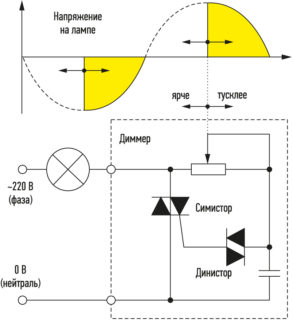
The range of switches with thermostats is represented by dozens of models, which differ from each other in the principle of operation, design solutions, type of control device and compatibility with different types of lamps.
- The rheostat-based dimmer switch is the first dimmer models, which are based on the change in current resistance using a resistor system. As the resistance decreased, the current increased, increasing the brightness of the lamps, and vice versa - the increase in resistance decreased the current, muffling the luminous flux. Rheostat switches are ineffective in terms of optimizing energy consumption. They are able to convert some of the electrical energy into heat, which does not allow you to experience resource savings.
- Dimmers of a triac type. The passage of current through a semiconductor triac is caused by the voltage between the electrodes. When the required voltage level is reached, the triac opens, allowing the flow to flow. A simultaneous decrease in resistance increases the current strength and gives the required brightness of the luminous flux.
The following letter marking allows to clarify the purpose and design of a specific switch model:
- Letter R - dimmer switch is designed to change the brightness of incandescent lamps with ohm or resistive load.
- Letter L - dimmers for step-down types of transformers used with low-voltage types of lamps.
- Letter C - models for electronic transformers.
Lamps of energy-saving and luminescent types, adapted to regulate the brightness of the luminous flux, are subject to special marking.
Connection diagrams
The installation of a dimmer switch is no different from the standard installation sequence for a conventional model. If it is necessary to connect a switch and a dimmer at the same time, it is better to place the latter closer to the usual resting place. If additional remote buttons are supplied in the kit, they can be mounted at a distance of up to 50 m from the dimmer. In this case, the phase wire is connected to the corresponding terminal of the dimmer and the first terminals of each button. The second button terminals are connected to terminal B on the controller. The load is connected to the second terminal of the dimmer and to the neutral wire.
Selection recommendations
To choose the right device, you should study the installation options:
- The standard connection option is light control from one point in the room.
- In the bedrooms, you can install two devices - at the entrance to the room and near the bed, which allows you to change the light intensity when going to bed.
- Let's say the option when the light regulation is carried out from one place, and the control - from two. It can be a switch at the entrance and two regulators in different areas of the room.
- Variant in the ratio "three control points and one control point". Here you can use pass-through dimmers, when turning on lamps in one area of the room automatically turns off lighting devices in others.
A variety of ways to connect a dimmer allows you to choose the best option for each room, taking into account the specifics of its operation.
Renowned dimmer manufacturers
Among the famous brands, it is worth highlighting:
- Schneider Electric (France). The devices of this company advantageously combine exclusive design and excellent build quality.
- Teco (Czech Republic). Dimmers of this brand offer to evaluate reliability, long and trouble-free service at an affordable price.
- Jung (Germany). The dimmers are distinguished by their original design, functionality and outstanding performance.
- Legrand (France). The company focuses on the release of high-tech models of a new generation, widely used in smart home systems.
- Gira (Germany). Dimmers of this brand are distinguished by a long service life, discreet design and reliability.
Also among the popular models - products from Siemens (Germany), offering to evaluate the combination of German reliability and functionality. Devices under the Godiva brand (Poland) are also in demand.These are inexpensive and high-quality models that meet all safety requirements.

